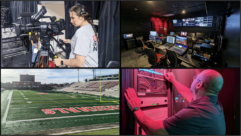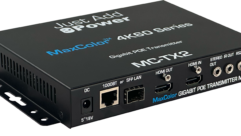Fiber Projects Link AV to IT Professionals
Jul 12, 2006 5:29 PM
For years now, they’ve been eyeing each other warily: The professional AV community trying to bring its clients all the benefits of an increasingly network-based toolbox, and information technology managers uneasy with the idea of letting anyone else connect anything to their nets.
Today, these two professional camps are working more closely together than ever before. That’s partly because conferencing, collaboration, and other video- and audio-intensive applications make up an increasing amount of network traffic. It’s also because the two sides are coming to understand each other better.
Often, the arena in which they meet and work together best rests on a fiber-optic backbone.
According to Glenn Polly of VideoSonic Systems in New York, AV integrators encounter these fiber backbones particularly among “power users” who have to move media and data around through a large space without trouble. “Universities, hotels, casinos, those clients are definitely where you are going to find fiber,” he says.
But some things have changed lately, he adds. For one, AV integrators themselves are frequently installing fiber. He also notes “Relations between AV and IT are improving as IT people understand that whether it’s Cat-5 cable or fiber, we’re not going to interfere with their network.”
This comfort level is important because for many years IT specialists have been loath to allow anyone, including AV integrators, to connect systems or devices to their networks.
“We’re road hogs,” says Jim Colquhoun, vice president of technical services at Audio Visual Innovations, Inc. in Englewood, Colo., giving one reason for this mistrust. “If you do conferencing, for example, it’s 600Kb bidirectionally, and I’m going to keep that completely occupied for the next three hours. The IT people’s heads spin… All they see (when they look at AV) is bandwidth hogs. We live with that reputation from the IT world.”
Moreover, Colquhoun adds, AV systems have demands and present complexities that IT people often don’t want to deal with. “Buildings weren’t built with grounding for AV systems in mind,” he notes as an example. Fiber connectivity can eliminate grounding problems for AV systems, but still, most fiber networks have not been built with AV requirements front and center.
Polly cites a trend that may be changing this situation, though. “We’re finding a lot of jobs where we’re actually pre-wiring for fiber but not terminating the fiber,” he says. For example, VideoSonic is working on a Manhattan hotel that will have a multimedia interface in each room. The fiber rises through a conduit adjacent to the elevators, and then branches out on each floor, terminating in a control panel in each room.
Some of this capacity is being used right away, and the rest is devoted to future-proofing, Polly says. The same strategy can apply to other applications, such as museums and university campuses, where long-haul distribution is handled by fiber, and local connections can be accomplished in a variety of ways.
You can go building to building over fiber but local distribution can be Cat-5 if you want,” Polly says. Hardware costs are coming down even as the complexity of the connections declines. Even though it’s becoming technically easier to link AV systems and devices to fiber networks, he adds, “some people still shy away from doing them. But they’re fun to do, the guy who can do it get[s] to show off on the job site.”










